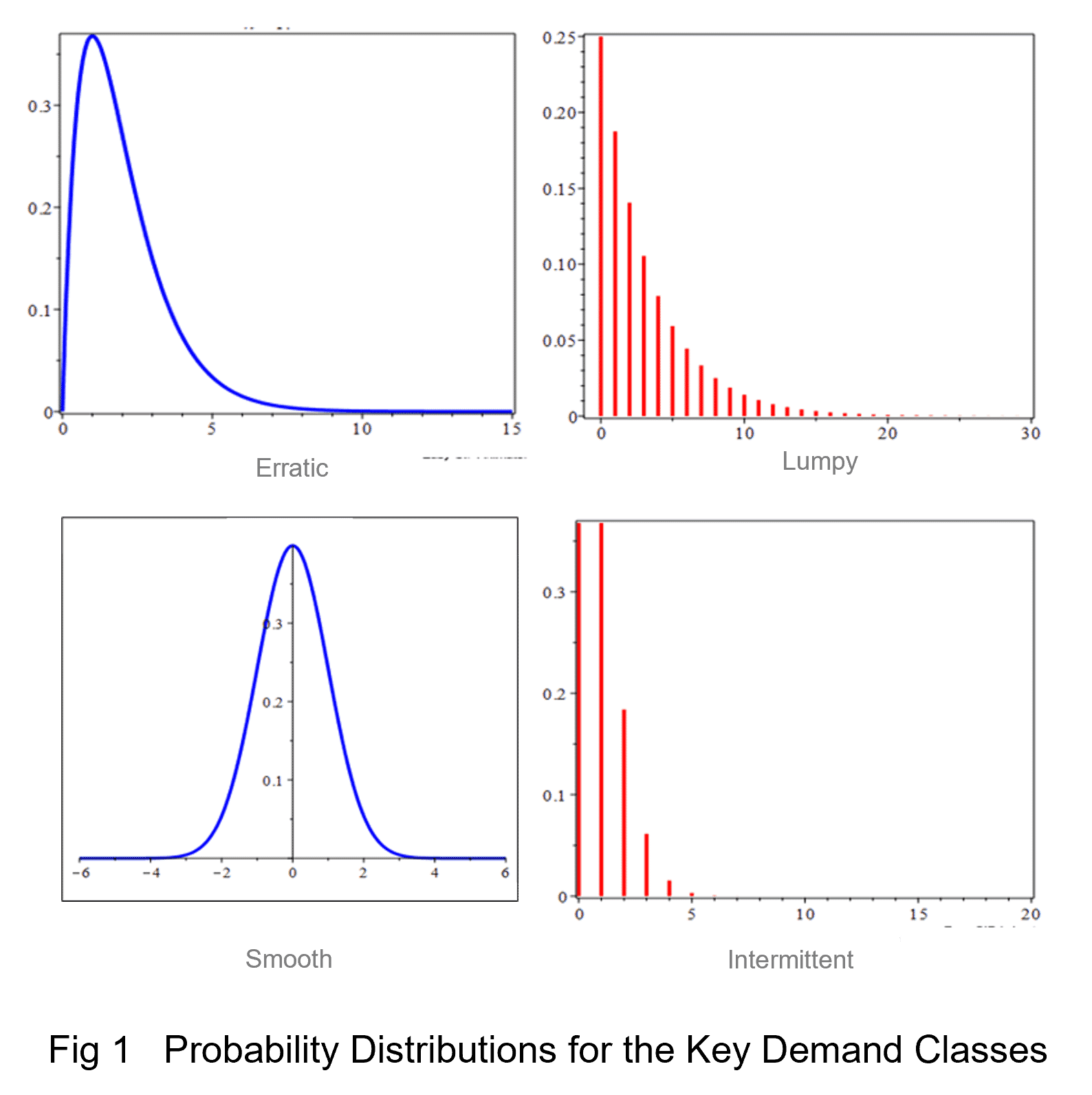Following last month’s post, I’ll discuss the merits of selecting the best planning policies and review the concept and value of economic metrics.
Clearly, all inventory systems contain many uncertainties, and these require a probability distribution of demand for items that can be replenished at either a certain level or point in time. Actually, it turns out that many statistical functions provide a faithful description of various demand phenomena – and these are readily available to help the practitioner determine the optimal values of key replenishment parameters; notably, safety stock levels and reorder points (Fig 1).

Demand Distributions
- In inventory management, the normal distribution often plays an important part, and its simple analytical properties enable the practitioner to easily compute the important control parameters. Despite its inherent restrictions, for the replenishment of Smooth demand items, this distribution is by far the most popular.
- When we encounter high variability in demand size and inter-demand intervals, the assumption of a normal distribution is often not appropriate. To model Erratic demand structures, the gamma distribution is an especially effective choice due to its flexibility (for higher volume items, this closely resembles the normal distribution and also is effective for lower volume items that are skewed).
- Inventory control under Intermittent demand is a challenging task (which is mostly due to the nature of the demand pattern) and in this case, the compound Poisson distribution is a standard choice in replenishment control models
- Lastly, for Lumpy demand patterns (recall that these exhibit comparably high demand variations and a high percentage of zero-demand events), a negative binomial distribution fits significantly better than other probability models and is found to be highly effective in optimising control parameters
Business Cases
- Recently, we were invited to review the replenishment process in a retail environment where traditional planning practices were informally derived and largely judgmental. Order histories of approximately two thousand commodities (corresponding to two-plus million units) were available to help us capture the qualitative behaviour of demand where the structure was observed to be dominated by Smooth and to a lesser degree, Erratic patterns (Fig 2).

This suggested that inventory replenishment could benefit from the use of normal and gamma-based planning rules. However, taking a practical view, it was sensible to propose and adopt the single normal planning model across the entire portfolio (since this represents half of the SKU population and 85% of the unit volume). So, on the strength of this single method alone, stock levels could be reduced by almost one-third with no degradation in service performance.
- This next example concerns the planning process for hardware items in which normal distribution rules were used to replenish stock internationally. Our investigation identified some two hundred SKUs in the portfolio that exhibited Intermittent behaviour and so, were amenable to a Poisson-type planning procedure. Having adopted this method, the planners could then re-tune the control parameters and over time, found this model enabled them to meet their 98% service level using half the traditional amount of stock.
The above provides two examples of the impact of matching your demand patterns to an appropriate planning model. It is clear to see that this can help improve your stock position while protecting your committed service targets – and in the process, reduce your working capital and associated expenses, including storage, handling, and holding costs.
Economic Drivers
Nowadays, quantitative techniques are commonly used to arrive at an optimal decision and to drive more efficient supply chains, i.e., a decision which takes account of all circumstances is considered to be the best one. In regard to inventory control, we must compare a number of quantitative factors in order to arrive at an appropriate model for the degree of service. So, provided we have a measurement system, we then need to define our objective, i.e., specify exactly what we wish to optimise.
Previously, I gave some thoughts on the nature of service metrics that are common throughout the industry, and it is clear that they have their limitations in optimisation. Finding the balance between targeted service and optimal inventory levels is therefore difficult to do on the basis of service level or fill rate KPIs alone (given their arbitrary nature).
However, understanding what constrains the values connected with your business strategy is useful, and once those are known, you can then select the target you wish to optimise. Certainly, if your target happens to be financially derived, you can be sure that it will not be abstract and so, will usually reflect the financial outcome of your supply chain decisions. Better still, properly executed, this will help improve bottom-line performance.
Having a knowledge of your financial drivers will help steer your focus towards inventory optimisation for high-quality service. Relevant factors to your supply chain execution could include constraints on storage space, costs for varying stock-out and obsolescence, price breaks, and so on.
The main benefit of this approach is that it can help you assess the true value of your purchasing decision. A monetary measure that reflects your supply chain decisions is tangible; furthermore – it gives you a reference for process improvement and ultimately, optimisation for service. At a minimum, this can give you the means to
- Track the margin generated by successfully fulfilling your customer demand to the agreed service level or fill rate
- Monitor the economic damage you could incur to your customer and yourself by not serving the product (stockout penalty and lost sales)
- Quantify your storage and handling costs
Finally, I hope this brief discussion provides you with some motivation to consider further the benefits of these two ideas. Taken together, I believe this approach will help align your supply chain to your business strategy and in the end, guide you to balance inventory risks with service satisfaction.
Supply Chain Enabled
